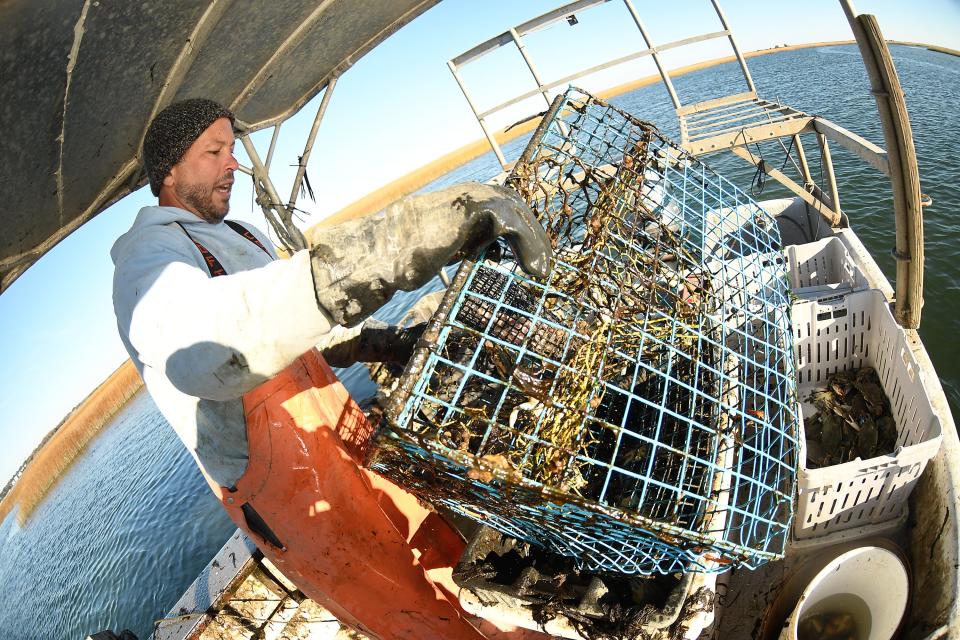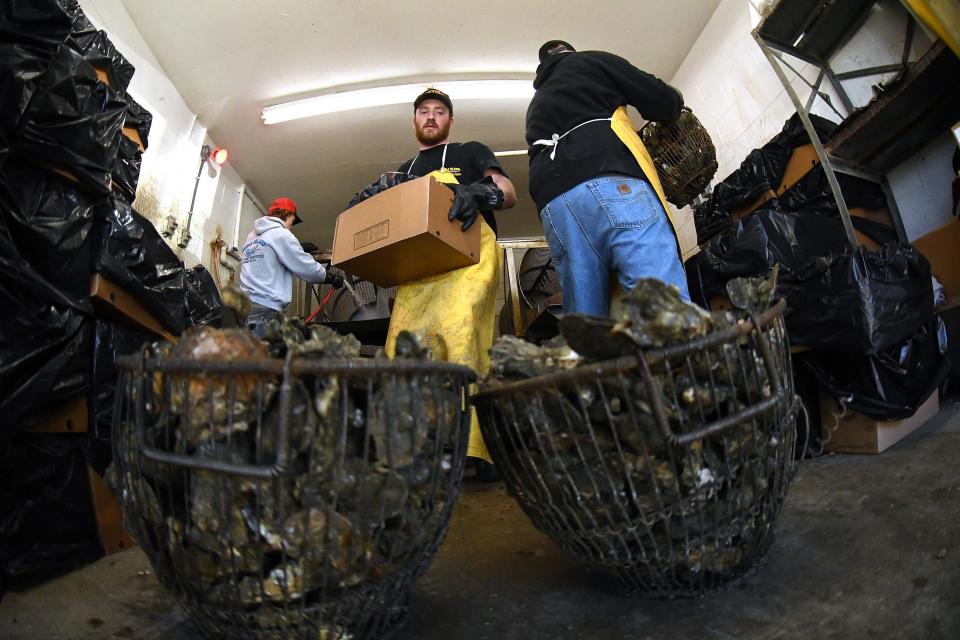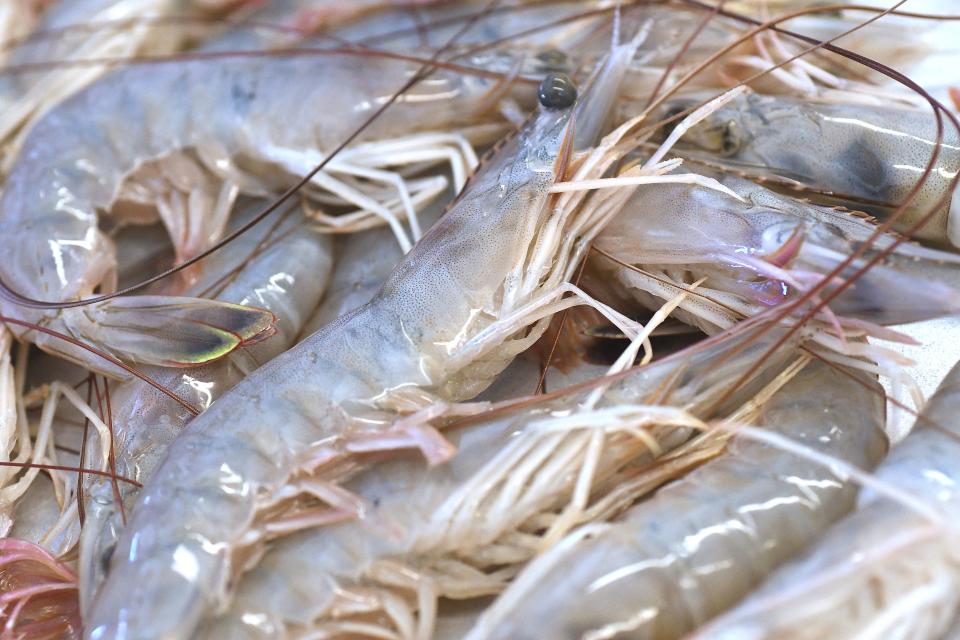Hook, line and sinking: What's the future of NC's commercial fishing industry?
With a well-trained hook of the line by one of the founders and co-owners of Wilmington's Seaview Crab Company, a few loops around the puller and a flick of a switch, the crab pot soon emerged.
Inside the pot, a dozen or so blue crabs scampered around, some using their impressive claws to attach themselves to the mesh-sides of the cage.
"It's not always easy, but this never gets old," Romano, 44, said as he emptied the crabs into a holding bin before checking to make sure they were all of legal size, the lucky ones getting tossed back into the waterway. The others were divided by size into containers to be sold individually − "These are the ones everyone wants," Romano joked as he held up a good-sized crab − or to be sent to a crab house to be picked apart for their meat.
"It just clears my head when I'm out here," Romano said with a Cheshire cat-like grin as he prepared to toss the now-empty pot back into the water. "I can leave most of my other problems behind for a few hours."
For generations, fishing has been a way of life in coastal North Carolina. The industry, which used to provide much of the seafood served along the U.S. East Coast, provided jobs and a good livelihood for the hardy souls who put in the long hours on the water. Communities evolved around the routines of fishing and the requirements of different fisheries, and local traditions and histories became intertwined with water.
But driven by factors as varied as rising operational costs, the declining health of many fisheries, the changing face of coastal towns as more retirees and property investors move in, increased foreign competition and even climate change, commercial fishing and the fishermen themselves are changing in North Carolina.
The industry isn't in danger of disappearing, but what it will become in the coming years and decades is still to be determined.

Challenging profession
Commercial fishing has never been easy.
The federal Occupational Safety and Health Administration lists commercial fishing as one of the most dangerous professions in the country, regularly ranking it first or second − with logging − for fatal injuries, with transportation-related incidents the leading cause of injuries and fatalities.
The unforgiving nature of the profession also has seen young people in recent decades often shying away from the long hours, tough work conditions and often small-town living associated with being a commercial fisherman. According to a 2017 study by the N.C. Division of Marine Fisheries, the average age of a commercial fishermen in North Carolina was 52, with the vast majority of them male and white. Commercial fishermen also had lived an average of 37 years in their current community, with 45% still living where they were born.
The U.S. seafood market also has changed. Consumers that used to accept having access to certain fish or seafood when it could be caught now want it available year round, as do restaurants and retailers. Price also has become a major factor. While industrial-style methods used in many forms of modern farming have helped keep prices of beef, pork and poultry generally affordable, that's often hard to do with seafood that in most cases can't be as readily raised in controlled conditions.
That's led to a surge in foreign imports to meet the country's seafood demand, often from places that aren't as environmentally responsible as the U.S. and rely on land-based farms to raise much of their fish, shrimp and other seafood at much lower costs. According to the National Oceanic and Atmospheric Administration (NOAA), the U.S. imports 70-85% of its seafood, with more than half of that produced via foreign aquaculture.
"Driven by imports, our national seafood seafood trade deficit has grown to $17 billion in 2020," the agency states.
Regulations too far?
In North Carolina, the number of participants in the commercial fishing industry has dropped from more than 5,000 in 2000 to fewer than 2,200 this year − a decrease of 57%. Other state statistics show the number of commercial permits and licenses issued by the state has decreased from more than 27,000 to around 19,300 in 2023. The number of fish dealer licenses also are falling as the industry shrinks, down 23% from 850 in 2000 to 655 in 2023.
So what's ailing the industry?
“You’re going to get 100 different answers from a 100 different people on that topic," said Dr. Louis Daniel, the former director of the N.C. Department of Marine Fisheries for nearly a decade before leaving in 2016 and now senior marine scientist at the N.C. Wildlife Federation and adjunct professor at N.C. State University.
The rise of the recreational fishery, which is now the economic driver of many coastal communities along with real estate and tourism, along with disappearing working waterfront infrastructure are commonly mentioned by commercial fishermen as major industry disruptors. According to state regulators, recreational fishermen in 2021 took nearly 18 million fishing trips in state waters, contributing almost 40,000 jobs and generating close to $1.7 billion in income and nearly $4.2 billion in sales. The value of seafood landed by commercial fishing vessels in North Carolina that same year was just under $69 million.
But it is overreaching regulations that are seen by many professional watermen as the real potential nail in the industry's coffin.
"They completely close a fishery and then those fishermen either have to hang up their nets or move to another fishery that's often already stressed and being fished by other fishermen," Romano said. "Either way, it heaps more pressure on the fishermen who are just trying to makes ends meat."
Daniel, who often drew the ire of the fishing community when in his old job, said limits on fisheries are the result of scientific assessments − although many commercial and recreational fishermen question the accuracy of the reporting methods − that showed the dire state many fisheries were due to overfishing or other factors.
"You can't keep doing what you've always been doing if the fish simply aren't there," he said, ticking off the crash in landings in recent decades of historically popular fisheries − blue crab, Southern flounder, weakfish, croaker and spot.

BROKEN FISHERY As flounder numbers flounder, NC fishermen stew over short recreational season
Politics vs. science
But doing what's good for the fishery often ran headfirst into history and tradition along the N.C. coast, and that brought a whole other issue into the mix: Politics.
Daniel said ignoring the science to protect constituents and certain constituencies has left North Carolina with a litany of fishery management plans that either haven't worked or not gone far enough due to political pressure.
“We’ve fished ourselves out of business in many cases because we’ve not taken into consideration the health of the public resource,” he said. “Instead, we’ve focused on pennies on the dollar.
“It’s a failure to do what’s in the best interest of the fishery."

Daniel said that push for short-term economic gain instead of taking the hard decisions to allow the fishery to really recover has created a feeder loop of fishermen − commercial and recreational − chasing fewer fish which eventually leads to more regulations that draws more political and public backlash. Case in point is the decision to severely restrict the Southern flounder fishing season, something that has upset nearly all fishermen because the fishery used to be open all year-round until just a few years ago and neighboring states haven't taken the draconian steps North Carolina has to allow the fishery to recover.
With both commercial and recreational fishermen unhappy with many of the decisions to limit or completely close fisheries, groups have turned to the courts. Cases have been filed seeking limits on shrimping in coastal waters and bycatch concerns to what type of nets commercial fishermen should be able to use due to their impacts on threatened and endangered species, like sea turtles.
The Coastal Conservation Association of N.C. has gone even further, filing a lawsuit stating that regulators have failed to uphold the state constitution by not managing fisheries in the public interest. Fishermen of all stripes also are worried that a NOAA proposal to place a 10-knot speed limit on vessels as small as 35 feet off much of the East Coast during varying time of the year to protect the highly endangered North Atlantic right whale could severely impact their businesses. The move has been pushed by a slew of environmental groups, noting that there are fewer than 360 of the marine mammals left and that vessel strikes are a leading killer of the slow-swimming, near-shore whales.
Cheap imports, albeit in some cases to feed demand that depleted local fisheries can no longer meet, also are playing a role in heaping pressure on commercial fishermen. Nowhere is that more true than in the shrimp fishery, where a regional association is pushing the Biden administration to declare a "shrimp emergency" in Gulf coast and Southern states, including North Carolina.
Excess capacity and oversupply, which some officials blame on aggressive aquaculture growth efforts in many Asian and Latin American countries by international financial organizations, has cut prices across the board, leaving U.S. fishermen struggling financially to compete while foreign producers respond by cutting prices to defend their market share.
High inflation, rising fuel costs, surging coastal property prices that are seeing working waterfronts turned into condos, and declining water quality are other headwinds fishermen face.
"I understand why people are getting out because they just can't make a living at it anymore," Daniel said. "It's a very tough environment out there."
BRAKING FOR WHALES Will small boats soon have to slow down off NC to protect endangered right whales?
INDUSTRY CHALLENGES Aging workforce, changing attitudes among challenges facing NC fishermen

'Glass half-full attitude'
When Joe Romano, his brother Sam and friend Nathan King decided to dive into crabbing back in 2006, with Joe putting aside his aspirations to be a college English professor, the biggest problem facing the 20-something group of friends wasn't too few crabs.
"There wasn't any infrastructure for us to use, so we had to build our own because we literally were on our own," he said. "So for a while there it wasn't like we had a business plan. It was more solving a different problem every week, every month.
"But that's what commercial fishermen are. They are problem solvers. They just go out there try things and figure it out."
As they learned the ropes, they moved from a curbside operations to a storefront. Now they have multiple locations, and supply restaurants and markets across the state.
While they've been lucky enough to succeed, Romano said he's seen what's happened to others in the industry in recent years.
"I try to have a glass half-full attitude," he said as he navigated his boat closer to Masonboro Island to check more of his nearly 300 pots he has from Wrightsville Beach south. "But it's hard some times."
Romano said he'd like to see the state be more pro-active in promoting its commercial fishing traditions, history and industry as a whole. He's also interested in whether some public-private partnerships could be developed to better promote the industry to young people and promote North Carolina seafood in new markets and to new consumers.
"People want local seafood," Romano said. "They want to eat what comes from nearby, what's fresh, and most of them are willing to pay a bit more to get that."

And as much as he's heard that niche operators and aquaculture like shellfish farming might be the future of commercial fishing in North Carolina, especially as regulations increase and many fisheries remain stressed or overfished, he still thinks there should be and needs to be a role for the larger traditional fishing operators in the industry.
While Romano said his crab landings can fluctuate from year to year, he hasn't seen the fishery fall off like has been reported in other parts of the state, which might call for a more "more nuanced" approach to management practices.
"You see change, and I really like seeing that out here," Romano said, ticking off how everything from water temperatures to rainfall and salinity levels to hurricane activity can determine whether he 's going to have a good crab haul or not. "Change is part of this business, but you get used to it."
He could be talking about his industry as a whole, too.
Reporter Gareth McGrath can be reached at GMcGrath@Gannett.com or @GarethMcGrathSN on Twitter. This story was produced with financial support from 1Earth Fund and the Prentice Foundation. The USA TODAY Network maintains full editorial control of the work.
This article originally appeared on Wilmington StarNews: The changing face of North Carolina's commercial fishing industry

